Use of the Gas Emission Site Type Method in the Evaluation of the CO2 Emissions in Raised Bogs
Abstract
:1. Introduction
2. Materials and Methods
2.1. Study Area
2.2. Gas Emission Site Type Method
- Greenhouse gas emissions are dependent on the average annual groundwater level.
- The groundwater level may be determined by the presence or absence of special groups of plant species.
- Given the similar hydrology of a study area, local vegetation may be classified as a certain collection of specific types of greenhouse gas emissions.
2.3. Field Measurements and Equipment Used
3. Limitations and Utility of the Study
4. Results
5. Discussion
6. Conclusions
Author Contributions
Funding
Data Availability Statement
Conflicts of Interest
References
- Page, S.E.; Rieley, J.O.; Banks, C.J. Global and regional importance of the tropical peatland carbon pool. Glob. Chang. Biol. 2011, 17, 798–818. [Google Scholar] [CrossRef]
- Xu, J.; Morris, P.J.; Liu, J.; Holden, J. PEATMAP: Refining estimates of global peatland distribution based on a meta-analysis. Catena 2018, 160, 134–140. [Google Scholar] [CrossRef]
- Strack, M.; Davidson, S.J.; Hirano, T.; Dunn, C. The Potential of Peatlands as Nature-Based Climate Solutions. Curr. Clim. Chang. Rep. 2022, 8, 71–82. [Google Scholar] [CrossRef]
- Kirpotin, S.N.; Antoshkina, O.A.; Berezin, A.E.; Elshehawi, S.; Feurdean, A.; Lapshina, E.D.; Pokrovsky, O.S.; Peregon, A.M.; Semenova, N.M.; Tanneberger, F.; et al. Great Vasyugan Mire: How the world’s largest peatland helps addressing the world’s largest problems. Ambio 2021, 50, 2038–2049. [Google Scholar] [CrossRef] [PubMed]
- de la Haye, A.; Devereux, C.; van Herk, S. Peatlands across Europe: Innovation & Inspiration; Bax & Company: Barcelona, Spain, 2021; Available online: https://baxcompany.com/wp-content/uploads/2018/08/peatlands-booklet.pdf (accessed on 15 May 2023).
- Harris, L.I.; Richardson, K.; Bona, K.A.; Davidson, S.J.; Finkelstein, S.A.; Garneau, M.; McLaughlin, J.; Nwaishi, F.; Olefeldt, D.; Packalen, M.; et al. The essential carbon service provided by northern peatlands. Front. Ecol. Environ. 2021, 20, 222–230. [Google Scholar] [CrossRef]
- Loisel, J.; Yu, Z.; Beilman, D.W.; Camill, P.; Alm, J.; Amesbury, M.J.; Anderson, D.; Andersson, S.; Bochicchio, C.; Barber, K.; et al. A database and synthesis of northern peatland soil properties and Holocene carbon and nitrogen accumulation. Holocene 2014, 24, 1028–1042. [Google Scholar] [CrossRef]
- Wang, J.; Sun, J.; Xia, J.; He, N.; Li, M.; Niu, S. Soil and vegetation carbon turnover times from tropical to boreal forests. Funct. Ecol. 2017, 32, 71–82. [Google Scholar] [CrossRef]
- Turetsky, M.R.; Benscoter, B.; Page, S.; Rein, G.; van der Werf, G.R.; Watts, A. Global vulnerability of peatlands to fire and carbon loss. Nat. Geosci. 2015, 8, 11–16. [Google Scholar] [CrossRef]
- Hugelius, G.; Loisel, J.; Chadburn, S.; Yu, Z. Large stocks of peatland carbon and nitrogen are vulnerable to permafrost thaw. Proc. Natl. Acad. Sci. USA 2020, 117, 20438–20446. [Google Scholar] [CrossRef]
- Turetsky, M.R.; Abbott, B.W.; Jones, M.C.; Anthony, K.W.; Olefeldt, D.; Schuur, E.A.G.; Grosse, G.; Kuhry, P.; Hugelius, G.; Koven, C.; et al. Carbon release through abrupt permafrost thaw. Nat. Geosci. 2020, 13, 138–143. [Google Scholar] [CrossRef]
- Ilnicki, P.; Iwaniszyniec, P. Emissions of greenhouse gases (GHG) from peatland. In Restoration of Carbon Sequestration Capacity and Biodiversity in Abandoned Grassland on Peatland in Poland; Ilnicki, P., Ed.; Publishing House of the Agricultural University in Poznań: Poznań, Poland, 2002; pp. 19–57. [Google Scholar]
- Yu, Z.; Loisel, J.; Brosseau, D.P.; Beilman, D.W.; Hunts, J. Global peatland dynamics since the Last Glacial Maximum. Geophys. Res. Lett. 2010, 37, L13402. [Google Scholar] [CrossRef]
- Kleinen, T.; Brovkin, V.; Munhoven, G. Modelled interglacial carbon cycle dynamics during the Holocene, the Eemian and Marine Isotope Stage (MIS) 11. Clim. Past 2016, 12, 2145–2160. [Google Scholar] [CrossRef]
- Gumbricht, T.; Roman-Cuesta, R.M.; Verchot, L.; Herold, M.; Wittmann, F.; Householder, E.; Herold, N.; Murdiyarso, D. An expert system model for mapping tropical wetlands and peatlands reveals South America as the largest contributor. Glob. Chang. Biol. 2017, 2017, 3581–3599. [Google Scholar] [CrossRef] [PubMed]
- Gorham, E. Northern peatlands: Role in the carbon cycle and probable responses to climatic warming. Ecol. Appl. 1991, 1, 182–195. [Google Scholar] [CrossRef] [PubMed]
- Turunen, J.; Tomppo, E.; Tolonen, K.; Reinikainen, A. Estimating carbon accumulation rates of undrained mires in Finland—application to boreal and subarctic regions. Holocene 2002, 12, 69–80. [Google Scholar] [CrossRef]
- Yu, Z.C. Northern peatland carbon stocks and dynamics: A review. Biogeosciences 2012, 9, 4071–4085. [Google Scholar] [CrossRef]
- Qi, J.; Zhang, X.; Lee, S.; Moglen, G.E.; Sadeghi, A.M.; McCarty, G.W. A coupled surface water storage and subsurface water dynamics model in SWAT for characterizing hydroperiod of geographically isolated wetlands. Adv. Water Resour. 2019, 131, 103380. [Google Scholar] [CrossRef]
- Panai, A.; Diaconu, A.; Galka, M.; Grindean, R.; Hutchinson, S.M.; Hickler, T.; Lamentowicz, M.; Mulch, A.; Tanţău, I.; Werner, C.; et al. Hydrological conditions and carbon accumulation rates reconstructed from a mountain raised bog in the Carpathians: A multi-proxy approach. Catena 2017, 152, 57–68. [Google Scholar] [CrossRef]
- Uri, V.; Kukumägi, M.; Aosaar, J.; Varik, M.; Becker, H.; Soosaar, K.; Morozov, G.; Ligi, K.; Padari, A.; Ostonen, I.; et al. Carbon budgets in fertile grey alder (Alnus incaba (L.) Moench.) stands of different ages. For. Ecol. Manag. 2017, 396, 55–67. [Google Scholar] [CrossRef]
- Haapalehto, T.O.; Vasander, H.; Jauhiainen, S.; Tahvanainen, T.; Kotiaho, J.S. The effects of peatland restoration on water-table depth, elemental concentrations, and vegetation: 10 years of changes. Restor. Ecol. 2011, 19, 587–598. [Google Scholar] [CrossRef]
- Price, J.S.; Ketcheson, S.J. Water relations in cutover peatlands. In Carbon Cycling in Northern Peatlands; American Geophysical Union: Washington, DC, USA, 2009; Volume 184, pp. 277–288. [Google Scholar] [CrossRef]
- Holden, J.; Evans, M.G.; Burt, T.P.; Horton, M. Impact of land drainage on peatland hydrology. J. Environ. Qual. 2006, 35, 1764–1778. [Google Scholar] [CrossRef] [PubMed]
- Jarašius, L.; Etzold, J.; Truus, L.; Purre, A.H.; Sendžikaitė, J.; Strazdiņa, L.; Zableckis, N.; Pakalne, M.; Bociąg, K.; Ilomets, M.; et al. Handbook for Assessment of Greenhouse Gas Emissions from Peatlands; Lithuanian Fund for Nature: Vilnius, Lithuania, 2021; 201p. [Google Scholar]
- Steffen, W.; Rockström, J.; Richardson, K.; Lenton, T.M.; Folke, C.; Liverman, D.; Summerhayes, C.P.; Barnosky, A.D.; Cornel, S.E.; Crucifix, M.; et al. Trajectories of the Earth system in the anthropocene. Proc. Natl. Acad. Sci. USA 2018, 115, 8252–8259. [Google Scholar] [CrossRef] [PubMed]
- Günther, A.; Barthelmes, A.; Huth, V.; Joosten, H.; Jurasinski, G.; Koebsch, F.; Couwenberg, J. Prompt rewetting of drained peatlands reduces climate warming despite methane emissions. Nat. Commun. 2020, 11, 1644. [Google Scholar] [CrossRef] [PubMed]
- Purre, A.H.; Pajula, R.; Ilomets, M. Carbon dioxide sink fun ction in restored milled peatlands—The significance of weather and vegetation. Geoderma 2019, 346, 30–42. [Google Scholar] [CrossRef]
- Trenberth, K.E. Changes in precipitation with climate change. Clim. Res. 2011, 47, 123–138. [Google Scholar] [CrossRef]
- Chen, X.; Buchberger, S.G. Exploring the relationships between warm-season precipitation, potential evaporation, and “apparent” potential evaporation at site scale. Hydrol. Earth Syst. Sci. 2018, 22, 4535–4545. [Google Scholar] [CrossRef]
- Taminskas, J.; Linkevičienė, R.; Šimanauskienė, R.; Jukna, L.; Kibirkštis, G.; Tamkevičiūtė, M. Climate change and water table fluctuation: Implications for raised bog surface variability. Geomorphology 2018, 304, 40–49. [Google Scholar] [CrossRef]
- Morris, P.J.; Baird, A.J.; Eades, P.A.; Surridge, B.W.J. Controls on Near-Surface Hydraulic Conductivity in a Raised Bog. Water Resour. Res. 2019, 55, 1531–1543. [Google Scholar] [CrossRef]
- Tiemeyer, B.; Heller, S.; Oehmke, W.; Gatersleben, P.; Bräuer, M.; Dettmann, U. Effects of water management and grassland renewal on the greenhouse gas emissions from intensively used grassland on bog peat. Agric. For. Meteorol. 2024, 345, 109858. [Google Scholar] [CrossRef]
- Lindroth, A.; Lund, M.; Nilsson, M.; Aurela, M.; Christensen, T.R.; Laurila, T.; Rinne, J.; Riutta, T.; Sagerfors, J.; Ström, L.; et al. Environmental controls on the CO2 exchange in north European mires. Tellus B Chem. Phys. Meteorol. 2007, 59, 812–825. [Google Scholar] [CrossRef]
- Janssens, I.A.; Freibauer, A.; Schlamadinger, B.; Ceulemans, R.; Ciais, P.; Dolman, A.J.; Joosten, H. The Global Peatland CO2 Picture. Peatland status and emissions in all countries of the world. Wetl. Int. 2009, 2009, 1–35. [Google Scholar]
- Oestmann, J.; Tiemeyer, B.; Düvel, D.; Grobe, A.; Dettmann, U. Greenhouse Gas Balance of Sphagnum Farming on Highly Decomposed Peat at Former Peat Extraction Sites. Ecosystems 2022, 25, 350–371. [Google Scholar] [CrossRef]
- Bianchi, A.; Larmola, T.; Kekkonen, H.; Saarnio, S.; Lång, K. Review of Greenhouse Gas Emissions from Rewetted Agricultural Soils. Wetlands 2021, 41, 108. [Google Scholar] [CrossRef]
- Aitova, E.; Morley, T.; Wilson, D.; Renou-Wilson, F. A review of greenhouse gas emissions and removals from Irish peatlands. Mires Peat 2023, 29, 1–17. [Google Scholar] [CrossRef]
- Tanneberger, F.; Birr, F.; Couwenberg, J.; Kaiser, M.; Luthardt, V.; Nerger, M.; Pfister, S.; Oppermann, R.; Zeitz, J.; Beyer, C.; et al. Saving soil carbon, greenhouse gas emissions, biodiversity and the economy: Paludiculture as sustainable land use option in German fen peatlands. Reg. Environ. Chang. 2022, 22, 69. [Google Scholar] [CrossRef]
- Beyer, C.; Höper, H. Greenhouse gas emissions from rewetted bog peat extraction sites and a Sphagnum cultivation site in Northwest Germany. Biogeosci. Discuss. 2014, 11, 4493–4530. [Google Scholar] [CrossRef]
- McCarter, C.; Wilkinson, S.; Moore, P.; Waddington, J. Ecohydrological trade-offs from multiple peatland disturbances: The interactive effects of drainage, harvesting, restoration and wildfire in a southern Ontario bog. J. Hydrol. 2021, 601, 126793. [Google Scholar] [CrossRef]
- Okruszko, H. Wirkung der Bodennutzung auf die Niedermoorentwicklung. Ergebnisse eines längjährigen Feldversuches. Z. F. Kult. Landentwickl. 1989, 30, 167–176. [Google Scholar]
- Oleszczuk, R.; Regina, K.; Szajdak, L.; Höper, H.; Maryganova, V. Impact of agricultural utilization of peat soils on the greenhouse gas balance. In Peatlands and Climate Change; Strack, M., Ed.; International Peat Society: Jyväskylä, Finland, 2008; pp. 70–97. [Google Scholar]
- Cillero, C.; Díaz-Varela, R.A.; Rubinos, M.; Ramil-Rego, P. Assessment of anthropogenic pressures on South European Atlantic bogs (NW Spain) based on hydrochemical data. Hydrobiologia 2016, 774, 37–154. [Google Scholar] [CrossRef]
- Howie, S.A.; Hebda, R.J. Bog surface oscillation (mire breathing): A useful measure in raised bog restoration. Hydrol. Process. 2018, 32, 1518–1530. [Google Scholar] [CrossRef]
- Joosten, H.; Tapio-Biström, M.L.; Tol, S. Peatlands—Guidance for Climate Change Mitigation through Conservation, Rehabilitation and Sustainable Use; FAO & Wetlands International: Ede, The Netherlands, 2012. [Google Scholar]
- Grønlund, A.; Hauge, A.; Hovde, A.; Rasse, D.P. Carbon loss estimates from cultivated peat soils in Norway: A comparision of three methods. Nutr. Cycl. Agroecosys. 2008, 81, 157–167. [Google Scholar] [CrossRef]
- Swenson, M.M.; Regan, S.; Bremmers, D.T.H.; Lawless, J.; Saunders, M.; Gill, L.W. Carbon balance of a restored and cutover raised bog: Implications for restoration and comparison to global trends. Biogeosciences 2019, 16, 713–731. [Google Scholar] [CrossRef]
- Schwill, S.; Haberl, A.; Strauss, A. Greenhouse Gas Emissions of Peatlands. Methodology for the Assessment of Climate Relevance—Case Study Zehlau Peatland; Michael Succow Foundation for Protection of Nature: Greifswald, Germany, 2010. [Google Scholar]
- Borówka, R.K.; Rotnicki, K. Explanations to the Detailed geological map of Poland 1, 50,000, Sheet Główczyce (11); Ministry of the Environment and the Polish Geological Institute: Warsaw, Poland, 2000. (In Polish)
- Tobolski, K. Climatic and ecological changes in the Quaternary period and the problem of changes in flora. Phytocenosis 1976, 5, 187–197. (In Polish) [Google Scholar]
- Chlost, I.; Sikora, M. The impact of anthropogenic pressure on the change of water relations in Gardno-Łeba lowland. Quaest. Geogr. 2015, 34, 17–31. [Google Scholar] [CrossRef]
- Kubiak-Wójcicka, K.; Owczarek, M.; Chlost, I.; Olszewska, A.; Nagy, P. Assessment of Meteorological Drought Trends in a Selected Coastal Basin Area in Poland—A Case Study. Water 2023, 15, 2836. [Google Scholar] [CrossRef]
- Tobolski, K. Holocene vegetational development based on the Kluki Reference Site in the Gardno–Łeba Plain. Acta Paleobot. 1987, 27, 179–222. [Google Scholar]
- Silvestrum. Baseline and Monitoring Methodology for the Rewetting of Drained Peatlands Used for Peat Extraction, Forestry or Agriculture Based on GESTs; Verified Carbon Standard Methodology, Version 3; Silvestrum: San Francisco, CA, USA, 2011. [Google Scholar]
- Couwenberg, J.; Thiele, A.; Tanneberger, F.; Augustin, J.; Bärisch, S.; Dubovik, D.; Liashchynskaya, N.; Michaelis, D.; Minke, M.; Skuratovich, A.; et al. Assessing greenhouse gas emissions from peatlands using vegetation as a proxy. Hydrobiologia 2011, 674, 67–89. [Google Scholar] [CrossRef]
- Couwenberg, J. Emission Factors for Managed Peat Soils (Organic Soils, Histosols). An Analysis of IPCC Default Values; Wetlands International: Ede, The Netherlands, 2009; 14p, Available online: https://www.wetlands.org/publication/emission-factors-for-managed-peat-soils-an-analysis-of-ipcc-default-values/ (accessed on 15 May 2023).
- Couwenberg, J. Vegetation as proxy for greenhouse gas fluxes—the GEST approach. In Carbon Credits from Peatland Rewetting. Climate—Biodiversity—Land Use; Tanneberger, F., Wichtmann, W., Eds.; Science, Policy, Implementation and Recommendations of a Pilot Project in Belarus; Schweizerbart: Stuttgart, Germany, 2011; pp. 37–52. [Google Scholar]
- Hiraishi, T.; Krug, T.; Tanabe, K.; Srivastava, N.; Jamsranjav, B.; Fukuda, M.; Troxler, T. Supplement to the 2006 IPCC Guidelines for National Greenhouse Gas Inventories: Wetlands, Methodological Guidance on Lands with Wet and Drained Soils, and Constructed Wetlands for Wastewater Treatment; IPPC: Geneva, Switzerland, 2013. [Google Scholar]
- Westhoff, V.; Van Der Maarel, E. The Braun-Blanquet Approach. In Classification of Plant Communities; Whittaker, R.H., Ed.; Springer: Dordrecht, The Netherlands, 1978; Volume 5-1. [Google Scholar] [CrossRef]
- Koska, I.; Succow, M.; Clausnitzer, U.; Timmermann, T.; Roth, S. Vegetationskundliche Kennzeichnung von Mooren (topische Betrachtung). In Landschaftsökologische Moorkunde; Succow, M., Joosten, H., Eds.; Schweizerbart: Stuttgart, Germany, 2001; pp. 112–184. [Google Scholar]
- Joosten, H.; Brust, K.; Couwenberg, J.; Gerner, A.; Holsten, B.; Permien, T.; Schäfer, A.; Tanneberger, F.; Trepel, M.; Wahren, A. MoorFutures®. Integration of Additional Ecosystem Services (Including Biodiversity) into Carbon Credits—Standard, Methodology and Transferability to Other Regions; MoorFutures: Integration of Additional Ecosystem Services (bfn.de); BfN-Skripten: Bonn, Germany, 2015; 120p. [Google Scholar]
- Cieśliński, R. The use of the GEST method to estimate greenhouse gases uptake or emissions in the absence of data for a raised bog. J. Water Land Dev. 2024, 60, 59–64. [Google Scholar] [CrossRef]
- Intergovernmental Panel on Climate Change (IPCC). Good Practice Guidance for Land Use, Land-Use Change and Forestry; IPPC: Geneva, Switzerland, 2003. [Google Scholar]
- Herrmann, A.; Bociag, K.; Ilomets, S.; Jarasius, L.; Makowska, M.; Pajula, R.; Pakalne, M.; Pawlaczyk, P.; Priede, A.; Sendzikaite, J.; et al. Report of LIFE Peat Restore, LIFE15 CCM/DE/000138. First Gest GHG Balance Scenarios “Reduction of CO2 Emissions by Restoring Degraded Peatlands in Northern European Lowland”; EU Commision: Brussels, Belgium, 2018. [Google Scholar]
- Pakalne, M.; Etzold, J.; Llomets, M.; Jarašius, L.; Pawlaczyk, P.; Bociang, K.; Chlost, R.; Gos, K.; Libaures, K.; Pajula, R.; et al. Best Practice Book for Peatland Restoration and Climate Change Mitigation. Experiences from LIFE Peat Restore Project; University of Latvia: Riga, Latvia, 2021; 184p. [Google Scholar]
- Chowdhury, A.; Naz, A.; Bhattacharyya, S.; Sanyal, P. Cost–benefit analysis of ‘Blue Carbon’ sequestration by plantation of few key mangrove species at Sundarban Biosphere Reserve, India. Carbon Manag. 2018, 9, 575–586. [Google Scholar] [CrossRef]
- Thomas, P.A.; Pearce, D.M.E. Role of cation exchange in preventing the decay of anoxic deep bog peat. Soil. Biol. Biochem. 2004, 36, 23–32. [Google Scholar] [CrossRef]
- Bobuľská, L.; Fazekašová, D.; Angelovičová, L. Vertical Profiles of Soil Properties and Microbial Activities in Peatbog Soils in Slovakia. Environ. Process. 2015, 2, 411–418. [Google Scholar] [CrossRef]
- Li, J.; Li, M.; Zhao, L.; Sun, X.; Gao, M.; Sheng, L.; Bian, H. Characteristics of soil carbon emissions and bacterial community composition in peatlands at different stages of vegetation succession. Sci. Total Environ. 2022, 839, 156242. [Google Scholar] [CrossRef] [PubMed]
- Sheppard, L.J.; Leith, I.D.; Leeson, S.R.; van Dijk, N.; Field, C.; Levy, P. Fate of N in a peatland, Whim bog: Immobilisation in the vegetation and peat, leakage into pore water and losses as N2O depend on the form of N. Biogeosciences 2013, 10, 149–160. [Google Scholar] [CrossRef]
- Evans, C.D.; Peacock, M.; Baird, A.J.; Artz, R.R.E.; Burden, A.; Callaghan, N.; Chapman, P.J.; Cooper, H.M.; Coyle, M.; Craig, E.; et al. Overriding water table control on managed peatland greenhouse gas emissions. Nature 2021, 593, 548–552. [Google Scholar] [CrossRef]
- Mcleod, E.; Chmura, G.L.; Bouillon, S.; Salm, R.; Björk, M.; Duarte, C.M.; Lovelock, C.E.; Schlesinger, W.H.; Sillima, B.R. A blueprint for blue carbon: Toward an improved understanding of the role of vegetated coastal habitats in sequestering CO2. Front. Ecol. Environ. 2011, 9, 552–560. [Google Scholar] [CrossRef]
- Ingram, H.A.P. Hydrology, in Ecosystems of the World 4A. In Mires: Swamp, Bog, Fen and Moor; Gore, A.J.P., Ed.; Elsevier: Amsterdam, The Netherlands, 1983; pp. 67–158. [Google Scholar]
- Bragg, O.M. Hydrology of peat-forming wetlands in Scotland. Sci. Total Environ. 2001, 294, 111–129. [Google Scholar] [CrossRef]
- Krohn, J.; Lozanovska, I.; Kuzyakov, Y.; Parvin, S.; Dorodnikov, M. CH4 and CO2 production below two contrasting peatland micro-relief forms: An inhibitor and δ13C study. Sci. Total Environ. 2017, 586, 142–151. [Google Scholar] [CrossRef] [PubMed]
- Leroy, F.; Gogo, S.; Guimbaud, C.; Francez, A.J.; Zocatelli, R.; Défarge, C.; Jannin, L.B.; Hu, Z.; Laggoun-Défarge, F. Response of C and N cycles to N fertilization in Sphagnum and Molinia-dominated peat mesocosms. J. Environ. Sci. 2019, 77, 264–272. [Google Scholar] [CrossRef]
- Yang, P.; Lai, D.; Huang, J.F.; Tong, C. Effect of drainage on CO2, CH4, and N2O fluxes from aquaculture ponds during winter in a subtropical estuary of China. J. Environ. Sci. 2018, 65, 72–82. [Google Scholar] [CrossRef] [PubMed]
- Lipińska, Z.; Cieśliński, R.; Pawłowska, M.; Chlost, I.; Pietruszyński, Ł. Human Impact on Water Circulation Patterns in Raised Bogs of the Baltic Type, Northern Poland. Sustainability 2023, 15, 12277. [Google Scholar] [CrossRef]
- Xiao, Q.; Xu, X.; Duan, H.; Qi, T.; Qin, B.; Lee, X.; Hu, Z.; Wang, W.; Xiao, W.; Zhang, M. Eutrophic Lake Taihu as a significant CO2 source during 2000–2015. Water Res. 2020, 170, 115331. [Google Scholar] [CrossRef] [PubMed]
- Tarnocai, C. The impact of climate change on Canadian peatlands. Can. Water Resour. J. 2009, 34, 453–466. [Google Scholar] [CrossRef]
- Hopple, A.M.; Wilson, R.M.; Kolton, M.; Zalman, C.A.; Chanton, J.P.; Kostka, J.; Bridgham, S.D. Massive peatland carbon banks vulnerable to rising temperatures. Nat. Commun. 2020, 11, 2373. [Google Scholar] [CrossRef] [PubMed]
- Ratcliffe, J.L.; Campbell, D.I.; Schipper, L.A.; Wall, A.M.; Clarkson, B.R. Recovery of the CO2 sink in a remnant peatland following water table lowering. Sci. Total Environ. 2020, 718, 134613. [Google Scholar] [CrossRef] [PubMed]
- Aubinet, M.; Vesala, T.; Papale, D. (Eds.) Eddy Covariance: A Practical Guide to Measurement and Data Analysis; Springer Science & Business Media: Berlin/Heidelberg, Germany, 2012; 438p. [Google Scholar]
- Collier, S.M.; Ruark, M.D.; Oates, L.G.; Jokela, W.E.; Dell, C.J. Measurement of greenhouse gas flux from agricultural soils using static chambers. J. Vis. Exp. 2014, 90, e52110. Available online: https://www.jove.com/pdf/52110/jove-protocol-52110-measurement-greenhouse-gas-flux-from-agricultural-soils-using-static (accessed on 20 May 2023). [CrossRef]
- Couwenberg, J.; Augustin, J.; Michaelis, D.; Joosten, H. Emission Reductions from Rewetting of Peatlands. Towards a Field Guide for the Assessment of Greenhouse Gas Emissions from Central European Peatlands; DUENE: Greifswald, Germany; RSPB: Sandy, UK, 2008; 28p. [Google Scholar]
- Reichelt, K.F. Evaluierung des GEST-Modells zur Abschätzung der Treibhausgasemissionen aus Mooren. Master’s Thesis, University of Greifswald, Greifswald, Germany, 2015; 55p. [Google Scholar]
- Audet, J.; Johansen, J.R.; Andersen, P.M.; Baattrup-Pedersen, A.; Brask-Jensena, K.M.; Elsgaard, L.; Kjaergaard, C.; Larsen, S.E.; Hoffmann, C.C. Methane emissions in Danish riparian wetlands: Ecosystem comparison and pursuit of vegetation indexes as predictive tools. Ecol. Indic. 2013, 34, 548–559. [Google Scholar] [CrossRef]
- Juszczak, R.; Augustin, J. Exchange of the greenhouse gases methane and nitrous oxide at a temperate pristine fen mire in Central Europe. Wetlands 2013, 33, 895–907. [Google Scholar] [CrossRef]
- Ojanen, P.; Minkkinen, K.; Penttilä, T. The current greenhou se gas impact of forestry-drained boreal peatlands. For. Ecol. Manag. 2013, 289, 201–208. [Google Scholar] [CrossRef]
- Günther, A.; Huth, V.; Jurasinski, G.; Glatzel, S. The effect of biomass harvesting on greenhouse gas emissions from a rewetted temperate fen. Glob. Chang. Biol. Bioenergy 2015, 7, 1092–1106. [Google Scholar] [CrossRef]
- Koch, S.; Jurasinski, G.; Koebsch, F.; Koch, M.; Glatzel, S. Spatial variability of annual estimates of methane emissions in a Phragmites australis (Cav.) Trin. Ex Steud. Dominated restored coastal brackish fen. Wetlands 2014, 34, 593–602. [Google Scholar] [CrossRef]
- Minke, M.; Augustin, J.; Burlo, A.; Yarmashuk, T.; Chuvashova, H.; Thiele, A.; Freibauer, A.; Tikhonov, V.; Hoffmann, M. Water level, vegetation composition, and plant productivity explain greenhouse gas fluxes in temperate cutover fens after inundation. Biogeosciences 2016, 13, 3945–3970. [Google Scholar] [CrossRef]
- Vanselow-Algan, M.; Schmidt, S.R.; Greven, M.; Fiencke, C.; Kutzbach, L.; Pfeiffer, E.-M. High methane emissions dominated annual greenhouse gas balances 30 years after bog rewetting. Biogeosciences 2015, 12, 4361–4371. [Google Scholar] [CrossRef]
- Wilson, D.; Farrell, C.A.; Fallon, D.; Moser, G.; Müller, C.; Renou-Wilson, F. Multiyear greenhouse gas balances at a rewetted temperate peatland. Glob. Chang. Biol. 2016, 22, 4080–4095. [Google Scholar] [CrossRef] [PubMed]
- Turbiak, J.; Ćwiklińska, P. Carbon dioxide exchange in a raised bog after natural regeneration of peat bog vegetation. Woda Sr. Obsz. Wiej. 2018, 18, 49–63. (In Polish) [Google Scholar]
- Turbiak, J.; Ćwiklińska, P. Assessment of the size of the carbon sequence in a transitional peatbog based on measurements of carbon dioxide fluxes. Woda Sr. Obsz. Wiej. 2018, 18, 44–53. (In Polish) [Google Scholar]
- Turbiak, J. Carbon balance in a meadow ecosystem on moderately decayed peat-muck soil. Woda Sr. Obsz. Wiej. 2012, 12, 281–294. (In Polish) [Google Scholar]
- Turbiak, J.; Ćwiklińska, P.; Duda, F. Carbon dioxide emission from raised bog surface after peat extraction. J. Water Land. Dev. 2017, 35, 237–242. [Google Scholar] [CrossRef]
- Renou-Wilson, F.; Moser, G.; Fallon, D.; Farrell, C.A.; Müller, C.; Wilson, D. Rewetting degraded peatlands for climate and biodiversity benefits: Results from two raised bogs. Ecol. Eng. 2019, 127, 547–560. [Google Scholar] [CrossRef]
- Rigney, C.; Wilson, D.; Renou-Wilson, F.; Müller, C.; Moser, G.; Byrne, K.A. Greenhouse gas emissions from two rewetted peatlands previously managed for forestry. Mires Peat 2018, 21, 1–23. [Google Scholar]
- Kiely, G.; Leahy, P.; McVeigh, P.; Lewis, C.; Sottocornola, M.; Laine, A.; Koehler, A.K. PeatGHG-Survey of GHG Emission and Sink Potential of Blanket Peatlands; Environmental Protection Agency: Wexford, Ireland, 2018; pp. 1–35.
- Wilson, D.; Mackin, F.; Tuovinen, J.P.; Moser, G.; Farrell, C.; Renou-Wilson, F. Carbon and climate implications of rewetting a raised bog in Ireland. Glob. Chang. Biol. 2022, 28, 6349–6365. [Google Scholar] [CrossRef]
- Beetz, S.; Liebersbach, H.; Glatzel, S.; Jurasinski, G.; Buczko, U.; Höper, H. Effects of land use intensity on the full greenhouse gas balance in an Atlantic peat bog. Biogeosciences 2013, 10, 1067–1082. [Google Scholar] [CrossRef]
- Salm, J.O.; Maddison, M.; Tammik, S.; Soosaar, K.; Truu, J.; Mander, Ü. Emissions of CO2, CH4 and N2O from undisturbed, drained and mined peatlands in Estonia. Hydrobiologia 2012, 692, 41–55. [Google Scholar] [CrossRef]
- Maljanen, M.; Komulainen, V.M.; Hytonen, J.; Martikainen, P.J.; Laine, J. Carbon dioxide, nitrous oxide and methane dynamics in boreal organic agricultural soils with different soil characteristics. Soil Biol. Biochem. 2004, 36, 1801–1808. [Google Scholar] [CrossRef]
- Tye, A.M.; Williamson, J.L.; Jarvie, H.P.; Dise, N.B.; Lapworth, D.J.; Monteith, D.; Sanders, R.; Mayor, D.J.; Bowes, M.J.; Bowes, M.; et al. Dissolved inorganic carbon export from rivers of Great Britain: Spatial distribution and potential catchment-scale controls. J. Hydrol. 2022, 615, 128677. [Google Scholar] [CrossRef]
- Bociąg, K.; Chlost, I.; Cieśliński, R.; Gos, K.; Kujawa-Pawlaczyk, J.; Makles, M.; Pawlaczyk, P. Peat bogs as coal reservoirs—intention to renaturize peat bogs in the Słowiński National Park. CEPL Stud. Mater. Rogów 2017, 19, 62–76. (In Polish) [Google Scholar]
- Premrov, A.; Wilson, D.; Saunders, M.; Yeluripati, J.; Renou-Wilson, F. CO2 fluxes from drained and rewetted peatlands using a new ECOSSE model water table simulation approach. Sci. Total Environ. 2021, 754, 14243. [Google Scholar] [CrossRef] [PubMed]
- Tuittila, E.S.; Vasander, H.; Laine, J. Sensitivity of C sequestration in reintroduced Sphagnum to water-level variation in a cutaway peatland restoration. Restor. Ecol. 2004, 12, 483–493. [Google Scholar] [CrossRef]
- Lamentowicz, M.; Gałka, M.; Marcisz, K.; Słowiński, M.; Kajukało-Drygalska, K.; Dayras, M.D.; Jassey, V.E. Unveiling tipping points in long-term ecological records from Sphagnum-dominated peatlands. Biol. Lett. 2019, 15, 20190043. [Google Scholar] [CrossRef]
- Kadlec, R.H.; Wallace, S.D. Treatment Wetlands; CRC Press: Boca Raton, FL, USA; Taylor & Francis Group: London, UK; New York, NY, USA, 2009. [Google Scholar]
- Schumann, M.; Joosten, H. Global Peatland Restoration Manual; Institute of Botany and Landscape Ecology, Greifswald University, Germany & International Mire Conservation Group: Greifswald Germany, 2018; Available online: http://www.imcg.net/pages/topics/projects/global-peatland-restoration-manual.php (accessed on 20 May 2023).
- Hartje, V.; Wüstemann, H.; Bonn, A. Naturkapital und Klimapolitik: Synergien und Konflikte; Technische Universität Berlin, Helmholtz-Zentrum für Umweltforschung—UFZ: Berlin, Germany; Leipzig, Germany, 2014. [Google Scholar]
- Lode, E.; Küttim, M.; Kiivit, I.K. Indicative effects of climate change on groundwater levels in Estonian raised bogs over 50 years. Mires Peat 2017, 19, 1–21. [Google Scholar] [CrossRef]
- Lehosmaa, K.; Jyväsjärvi, J.; Virtanen, R.; Rossi, P.M.; Rados, D.; Chuzhekova, T.; Markkola, A.; Ilmonen, J.; Muotka, T. Does habitat restoration enhance spring biodiversity and ecosystem functions? Hydrobiologia 2017, 793, 161–173. [Google Scholar] [CrossRef]
- Fortuniak, K.; Pawlak, W.; Bednorz, L.; Grygoruk, M.; Siedlecki, M.; Zieliński, M. Methane and carbon dioxide fluxes of a temperate mire in Central Europe. Agric. For. Meteorol. 2017, 232, 306–318. [Google Scholar] [CrossRef]
- Xiao, Q.; Xiao, W.; Luo, J.; Qiu, Y.; Hu, C.; Zhang, M.; Qi, T.; Duan, H. Management actions mitigate the risk of carbon dioxide emissions from urban lakes. J. Environ. Manag. 2023, 344, 118626. [Google Scholar] [CrossRef] [PubMed]
- Martens, M.; Karlsson, N.P.E.; Ehde, P.M.; Mattsson, M.; Weisner, S.E.B. The greenhouse gas emission effects of rewetting drained peatlands and growing wetland plants for biogas fuel production. J. Environ. Manag. 2021, 277, 111391. [Google Scholar] [CrossRef] [PubMed]
- Okruszko, T.; Duel, H.; Acreman, M.; Grygoruk, M.; Flörke, M.; Schneider, C. Broad-scale ecosystem services of European wetlands—Overview of the current situation and future perspectives under different climate and water management scenarios. Hydrol. Sci. J. 2011, 56, 1501–1517. [Google Scholar] [CrossRef]
- Mirosław-Świątek, D.; Kiczko, A.; Szporak-Wasilewska, S.; Grygoruk, M. Too wet and too dry? Uncertainty of DEM as a potential source of significant errors in a model-based water level assessment in riparian and mire ecosystems. Wetl. Ecol. Manag. 2017, 25, 547–562. [Google Scholar] [CrossRef]
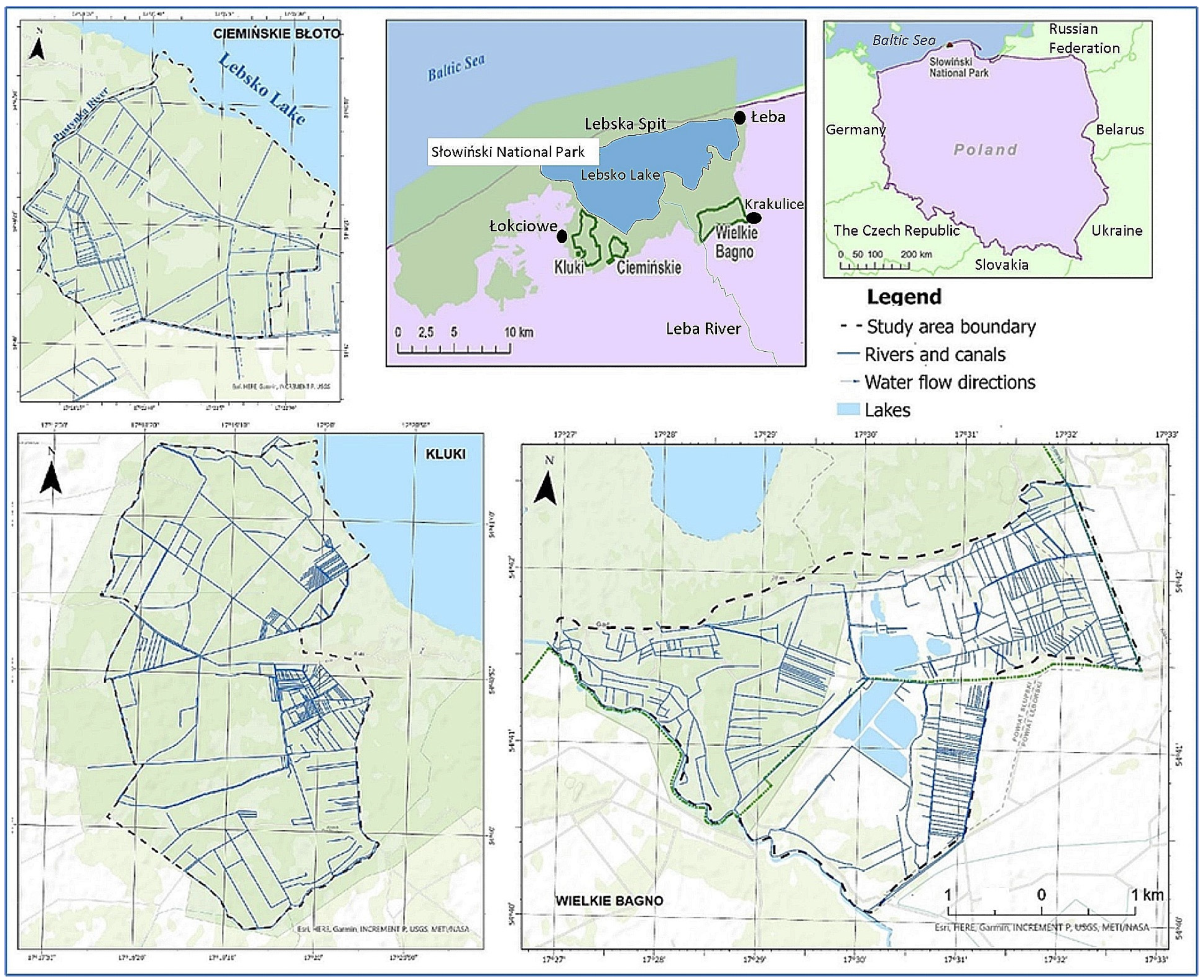
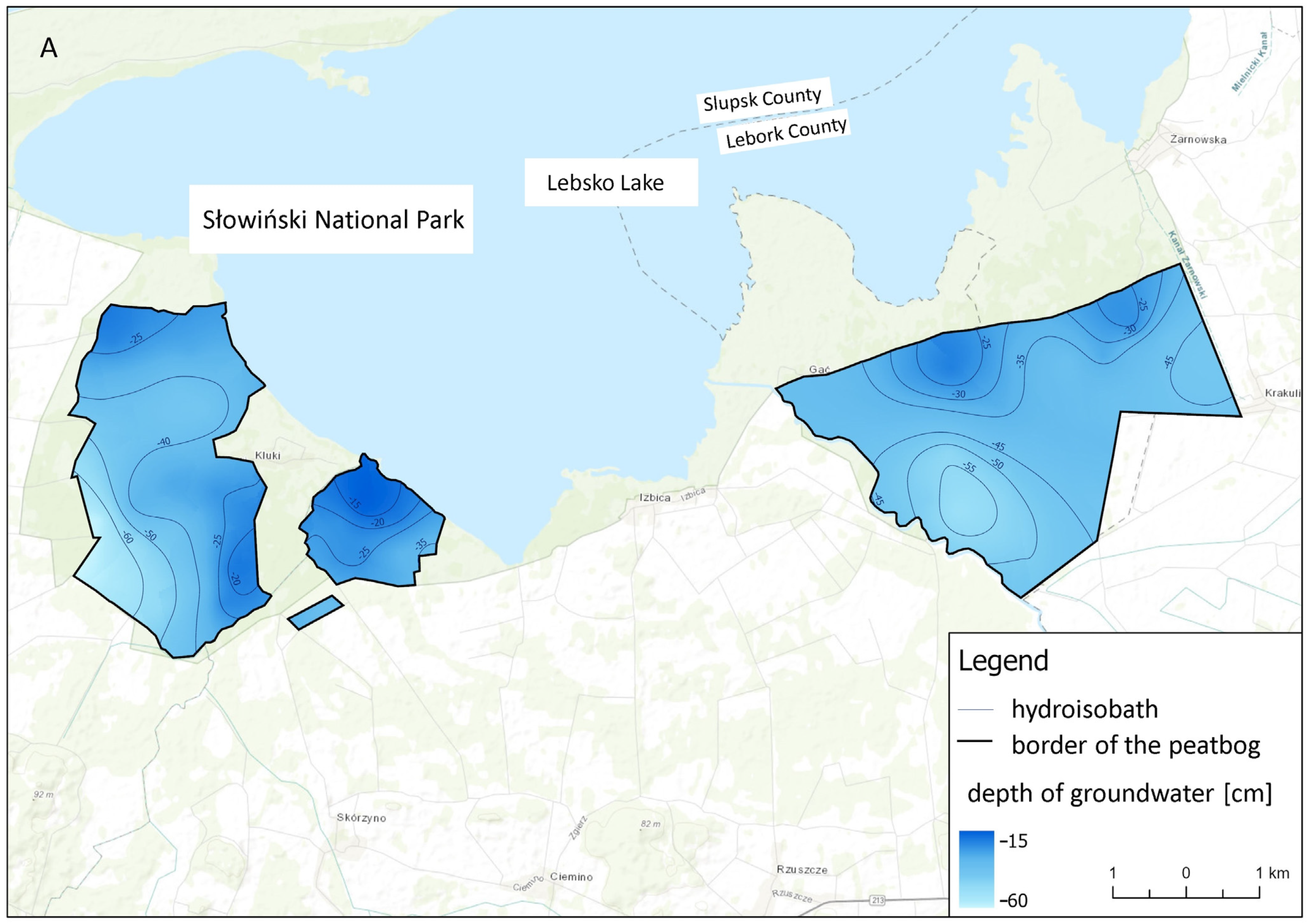
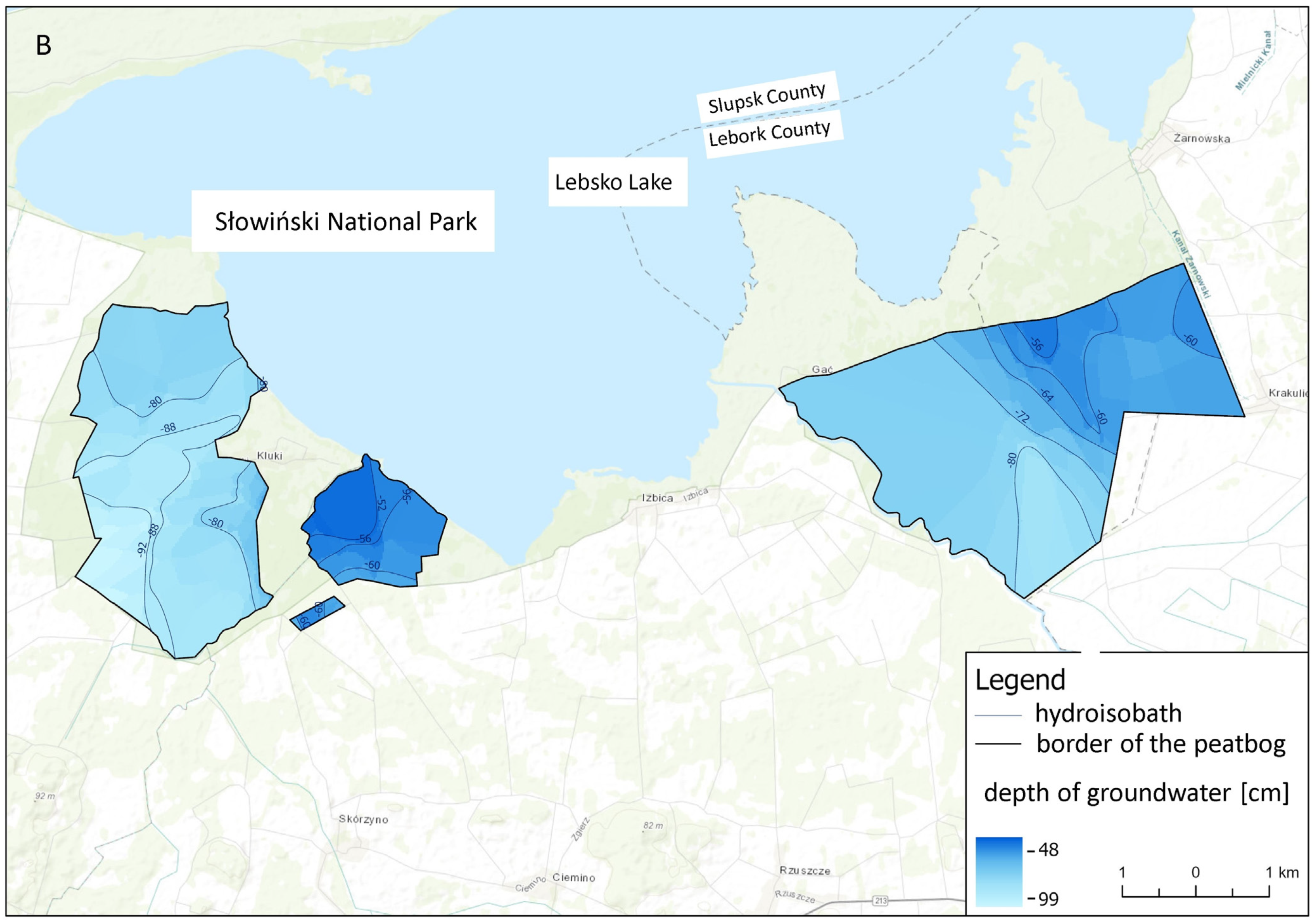

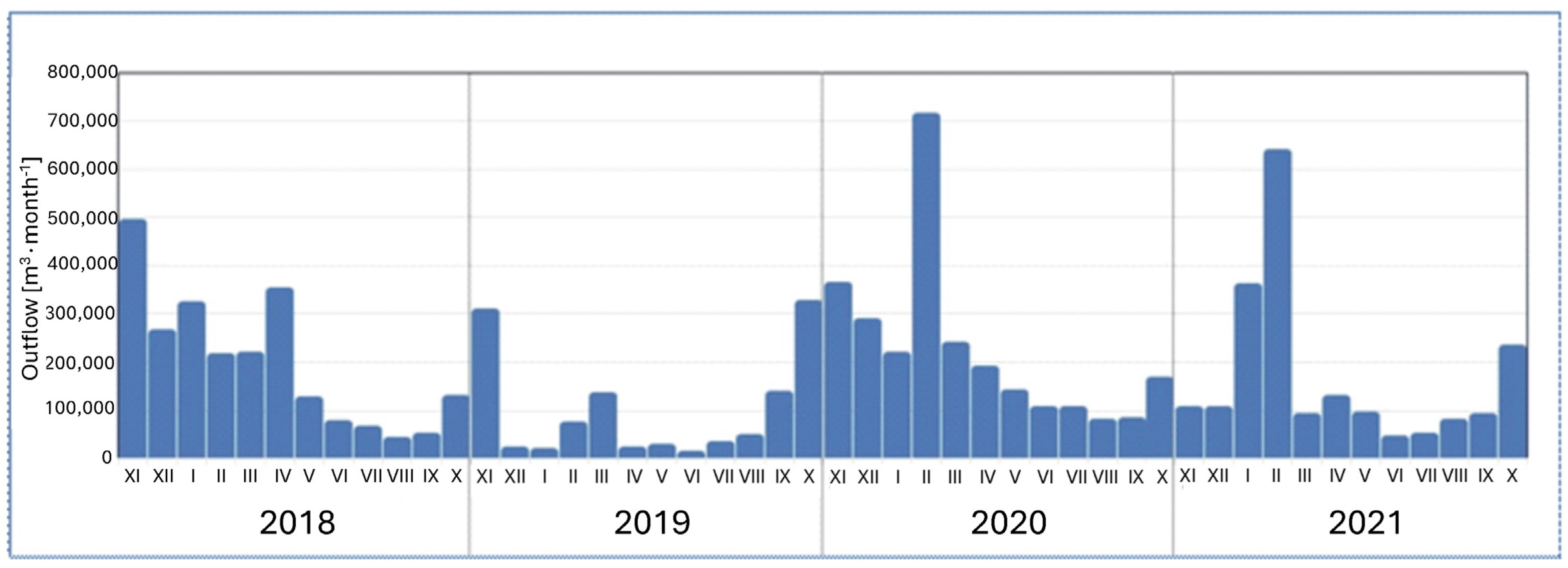

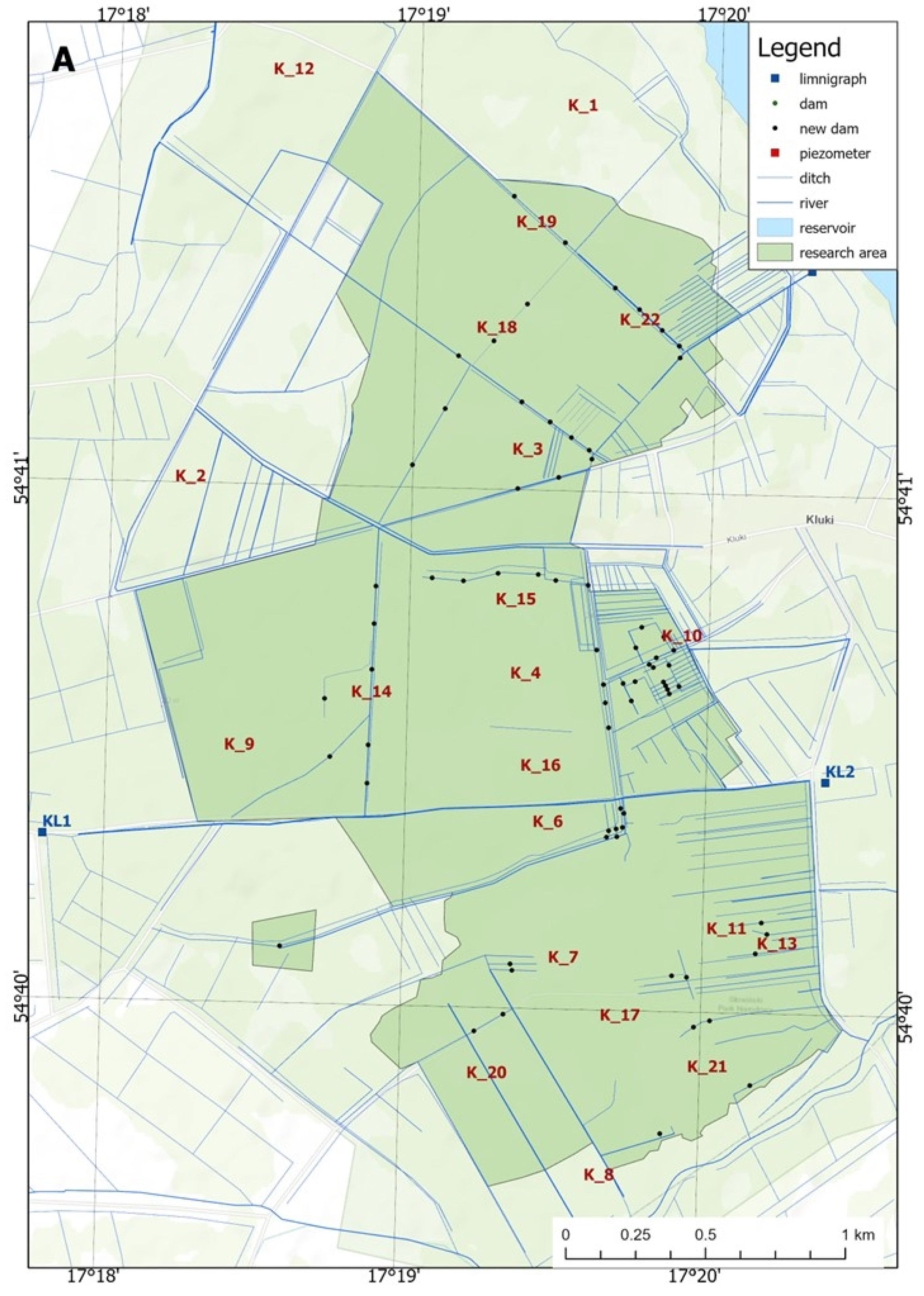
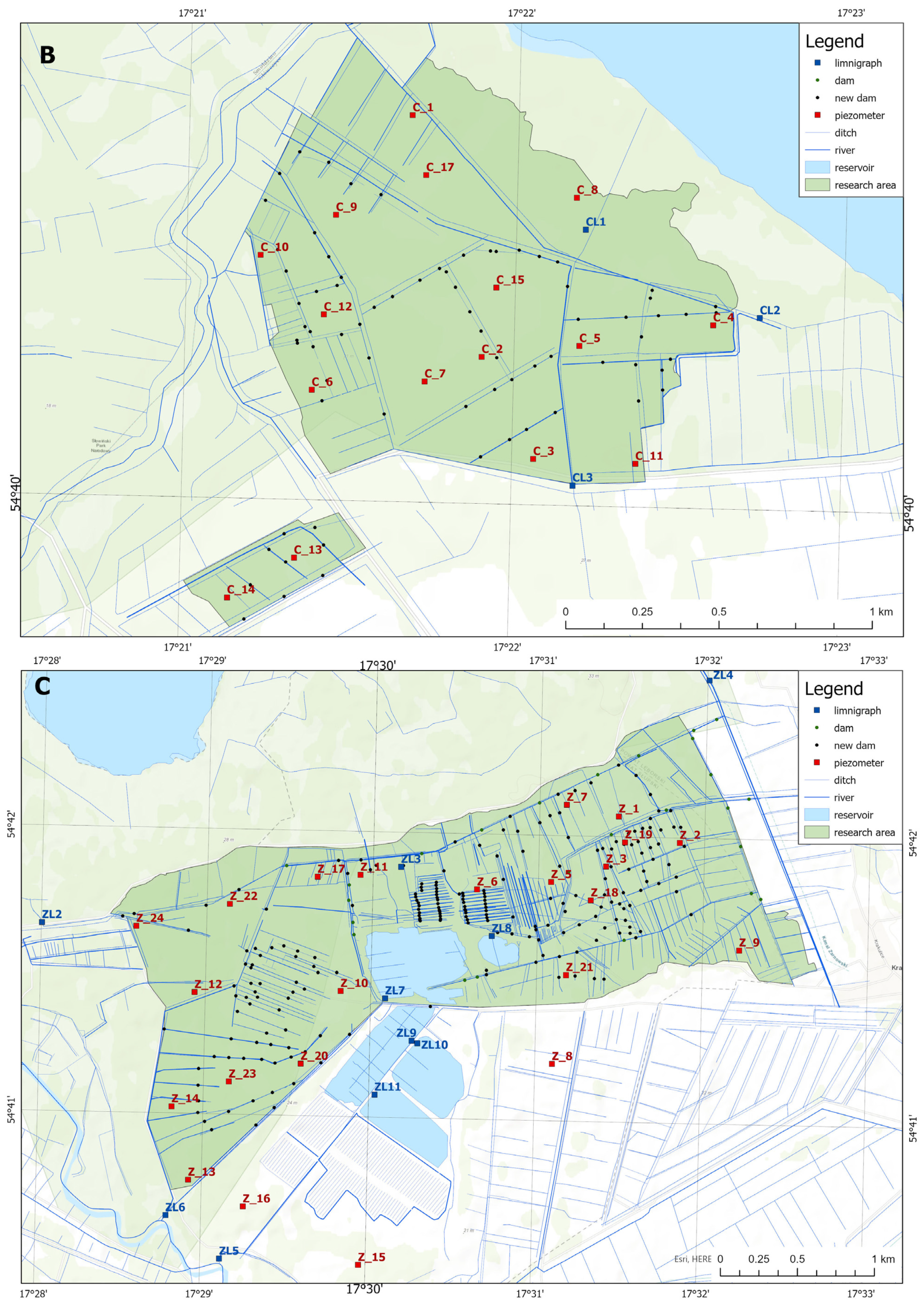


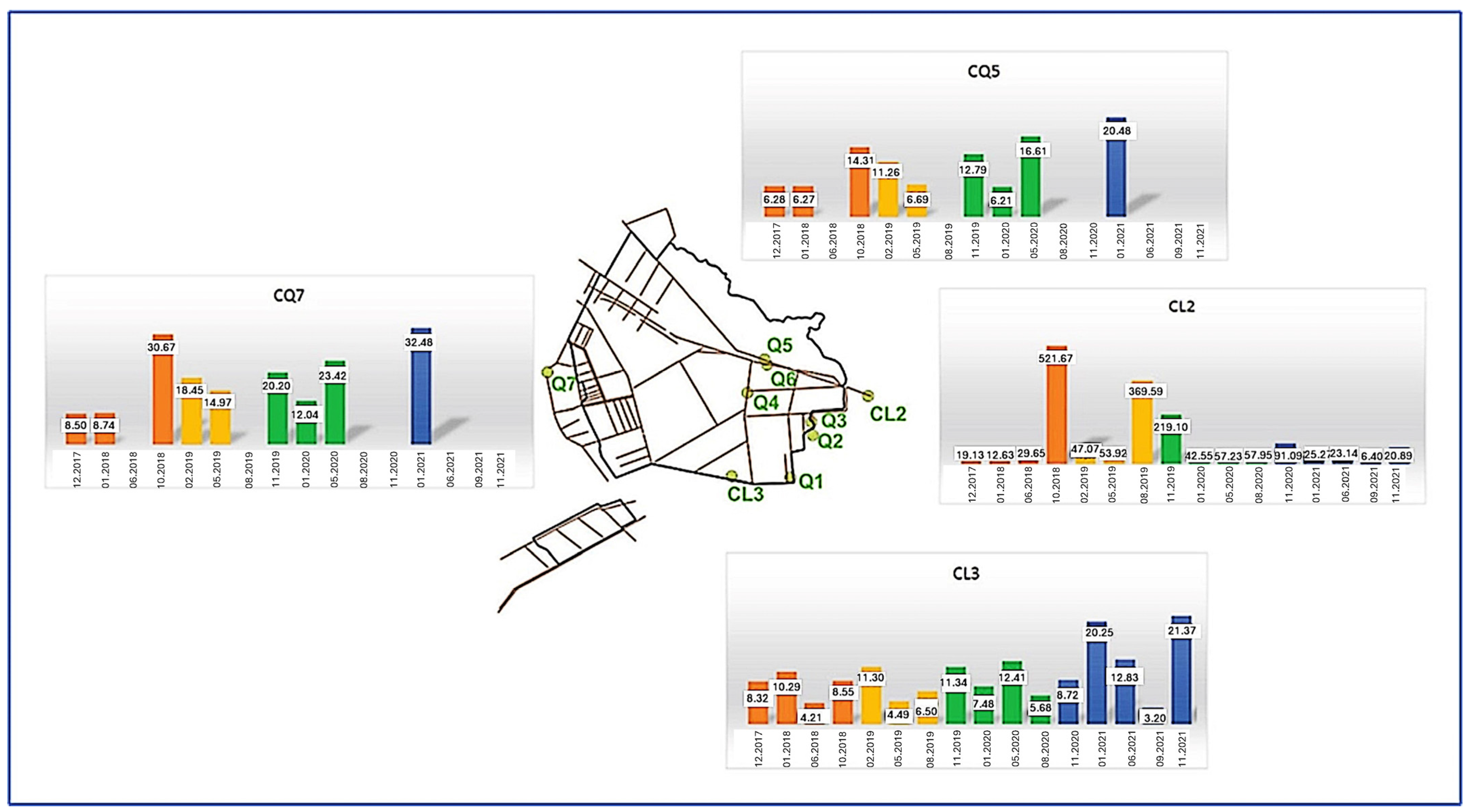
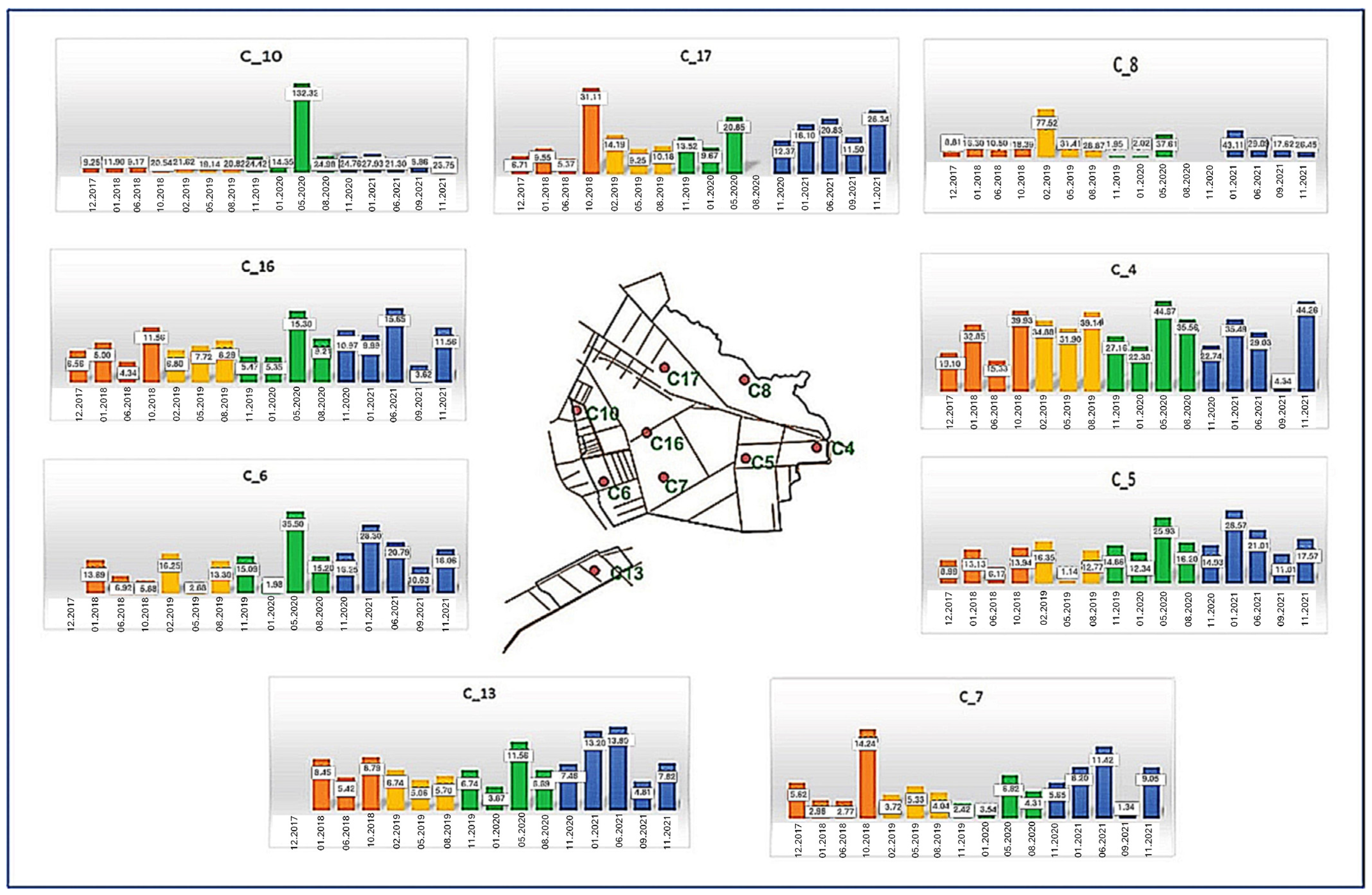
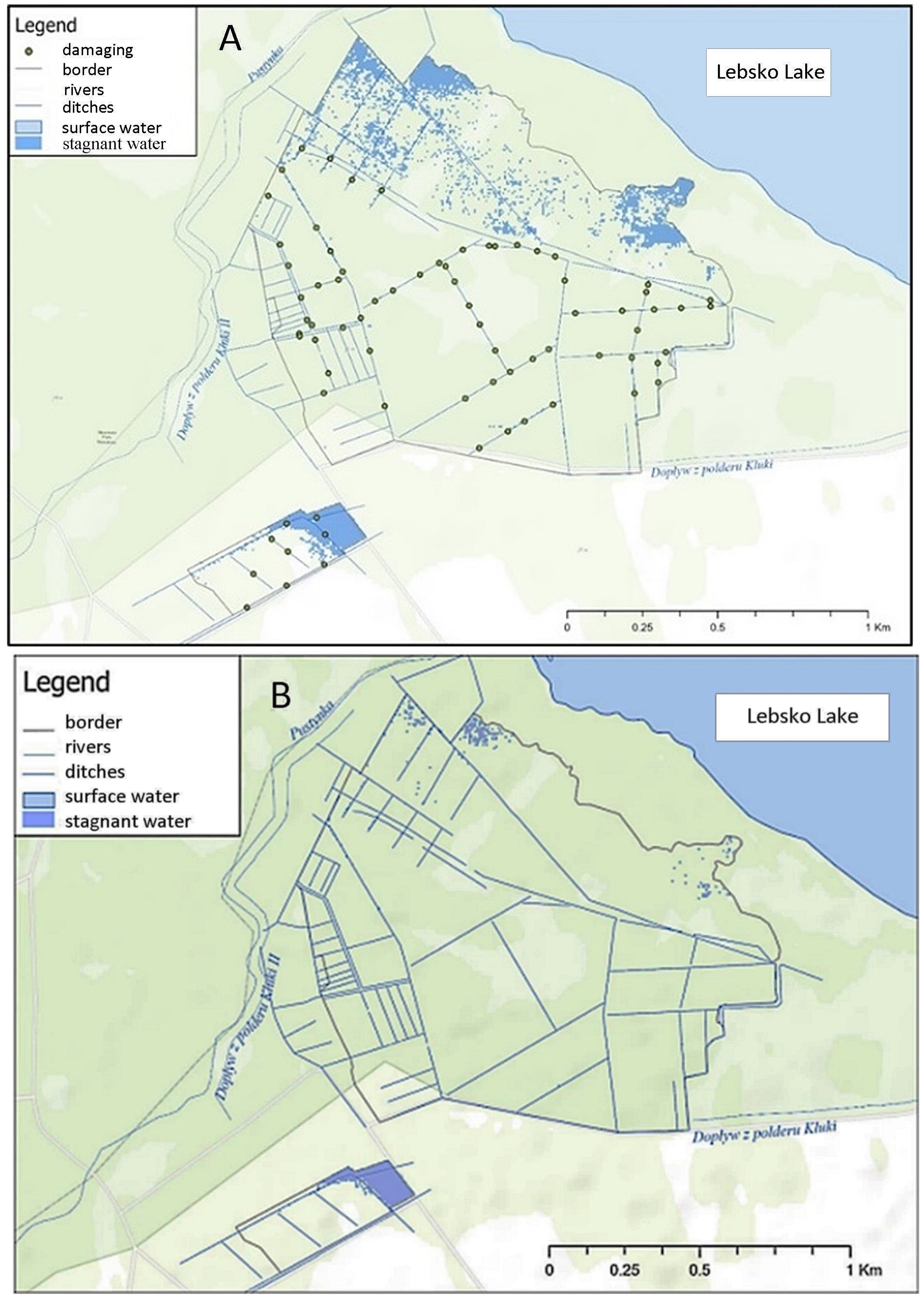
| GEST-Type | Kluki Area [ha] | Ciemińskie Błoto Area [ha] | Wielkie Błoto Area [ha] |
|---|---|---|---|
| Moderately Moist (Forb) Meadow | 14.29 | 1.08 | 6.80 |
| Moderately Moist/Dry Bog Heath | - | - | 8.63 |
| Moist Bog Heath | 0.43 | - | 0.03 |
| Bare Peat (Wet) | - | - | 1.71 |
| Bare Peat (Moist) | - | - | 0.57 |
| Very Moist Bog Heath | - | 1.21 | 12.95 |
| Very Moist Peat Moss Lawn | 1.36 | 5.61 | 23.02 |
| Wet Tall Sedges Reeds | - | 3.47 | 0.55 |
| Wet Small Sedges Reeds mostly with Moss Layer | 0.01 | 1.68 | 1.93 |
| Wet Tall Reeds | - | - | 0.04 |
| Wet Peat Moss Lawn | - | - | 0.67 |
| Peat Moss Lawn on Former Peat-Cut-Off Areas | 14.91/0.75 | 2.36 | 86.46 |
| Wet Peat Moss Lawn with Pine Trees | - | - | 14.07 |
| Wet Peat Moss Hollows resp. Flooded Peat Moss Lawn | - | - | 0.25 |
| Open Water/Ditches | 1.11 | - | 21.38 |
| Dry Oligotrophic Forests and Shrubberies | 9.82 | - | 4.95 |
| Moderately Moist Oligotrophic Forests and Shrubberies | 432.63 | 80.37 | 265.90 |
| Moist Oligotrophic Forests and Shrubberies | 29.93/0.75 | 23.34 | 98.59 |
| Very Moist Oligotrophic Forests and Shrubberies | 1.5 | 7.48 | 0.55 |
| Moderately Moist Mesotrophic/Eutrophic Forests and Shrubberies | 432.63 | - | - |
| Very Moist Mesotrophic/Eutrophic Forests and Shrubberies | 1.5 | 7.48 | - |
| Wet Mesotrophic/Eutrophic Forests and Shrubberies | - | 36.77 | - |
| GEST-Type | CO2 | CH4 | CO2 | CH4 | ||||
|---|---|---|---|---|---|---|---|---|
| Without Woods | With Woods | |||||||
| Base | Post | Base | Post | Base | Post | Base | Post | |
| Open Peatbogs | ||||||||
| Moderately Moist (Forb) Meadows | 443.40 | 104.40 | 0.00 | 0.00 | 443.40 | 104.40 | 0.00 | 0.00 |
| Peat Moss Lawn on former Peat-Cut-Off Areas | 159.9 | 210.90 | 38.53 | 50.81 | 159.90 | 210.90 | 38.53 | 50.81 |
| Very Moist Peat Moss Lawn | −32.8 | −45.10 | 103.29 | 141.95 | −32.80 | −45.10 | 103.29 | 141.95 |
| Very Moist Bog Heath | 25.3 | 1.80 | 64.66 | 12.32 | 25.30 | 1.80 | 64.66 | 12.32 |
| Wet Small Sedges Reeds Mostly with Moss Layer | −12.70 | −8.20 | 24.59 | 15.90 | −12.70 | −8.20 | 24.59 | 15.90 |
| Wet Tall Sedges Reeds | −0.40 | −0.50 | 34.18 | 36.22 | −0.40 | −0.50 | 34.18 | 36.22 |
| Moist Bog Heath | 4.34 | 4.04 | 0.00 | 0.00 | 4.34 | 4.04 | 0.00 | 0.00 |
| Open Water/Ditches | N/D | N/D | 63.73 | 79.82 | N/D | N/D | 63.73 | 79.82 |
| Moderately Moist Bog Heath | N/D | - | N/D | - | N/D | - | N/D | - |
| Wet Peat Moss Lawn with Pine Trees | 54.20 | - | 3.10 | - | 54.20 | - | 3.10 | - |
| Wet Peat Moss Lawn | −0.40 | −17.4 | 0.17 | 8.11 | −0.40 | −17.40 | 0.17 | 8.11 |
| Bare Peat (Moist | 3.50 | - | −0.01 | - | 3.50 | - | −0.01 | - |
| Bare Peat (Wet) | 2.50 | - | 0.14 | - | 2.50 | - | 0.14 | - |
| Wet Peat Moss Hollows resp. Flooded Peat Moss Lawn | −0.80 | −0.80 | 3.01 | 3.01 | −0.80 | −0.80 | 3.01 | 3.01 |
| Wet Tall Reeds | −0.10 | −0.10 | 0.25 | 0.25 | −0.10 | −0.10 | 0.25 | 0.25 |
| Moist Reeds and Meadows | - | 26.0 | - | 42.28 | - | 26.0 | - | 42.28 |
| Forested Peatbogs | ||||||||
| Moderately Moist Forests and Shrubberies | 15,578 | 12,081.00 | 0.00 | 0.00 | 1555.20 | 12,008.40 | 0.00 | 0.00 |
| Moist Forests and Shrubberies | 701.2 | 1199.80 | 1143.51 | 1956.85 | 689.80 | 1190.40 | 1143.51 | 1956.85 |
| Very Moist Forests and Shrubberies | 16.20 | 100.40 | 28.59 | 177.54 | 16.00 | 100.30 | 28.51 | 177.54 |
| Wet Forests and Shrubberies | 129.70 | −129.70 | 249.83 | 249.83 | −131.00 | −131.00 | 249.83 | 249.83 |
| Moderately Dry Forests and Shrubberies | 384.30 | 370.60 | 0.00 | 0.00 | 382.40 | 369.00 | 0.00 | 0.00 |
| Reduction Potentials | −3298.80 | +1017.32 | −3296.20 | +1017.32 | ||||
| Peatbog/Country | Results |
|---|---|
| Black swamp raised peatbog/Poland [96] | CO2 emission: 0.5 Mg·ha−1·year−1 |
| Raised peatbog where natural regeneration of peatbog vegetation has occurred/Poland [97] | C accumulation: 0.9 Mg·ha−1·year−1 |
| Raised peatbog in Noteć River Valley/Poland [98] | CO2 emission: 11.9 Mg·ha−1 |
| Raised peatbog after peat extraction/Poland [99] | CO2 emission: 19.7 Mg·h−1·year−1 |
| Raised peatbog/Ireland [100] | CO2 emission: 137 ± 24 g·m−2·year−1 |
| Blanked bog (1) and a high re-wetted peatbog (2)/Ireland [101] | 1. CO2 emission: 131 ± 298.3 g·m−2·year−1 |
| 2. CO2 emission: 585.3 ± 241.5 g·m−2·year−1 | |
| Atlantic type raised peatbog/Ireland [102] | CO2 emission: 220.8 g·m−2 to 244.8 g·m−2 |
| Re-wetted peatbog (1) and drained peatbog (2)/Ireland [103] | 1. C accumulation: 78.0 ± 37.6 g·m−2·year−1 2. CO2 emission: 157 ± 25.5 g·m−2·year−1 |
| Degraded peatbog (1) and natural peatbog (2)/Germany [104] | 1. CO2 emission: 470 ± 247 g·m−2·year−1 2. C accumulation: −68 ± 104 g·m−2·year−1 |
| Drained peatbog/Estonia [105] | Emission 0 to 138 mg·m−2·h−1 |
| Soils under barley had higher (1) and soils under grass (2)/Finland [106] | 1. CO2 emission: 830 g·m−2·year−1 2. CO2 emission: 395 g m−2·year−1 |
| Catchment/Great Britain [107] | CO2 emission: 0.56 t·km−2·year−1 |
Disclaimer/Publisher’s Note: The statements, opinions and data contained in all publications are solely those of the individual author(s) and contributor(s) and not of MDPI and/or the editor(s). MDPI and/or the editor(s) disclaim responsibility for any injury to people or property resulting from any ideas, methods, instructions or products referred to in the content. |
© 2024 by the authors. Licensee MDPI, Basel, Switzerland. This article is an open access article distributed under the terms and conditions of the Creative Commons Attribution (CC BY) license (https://creativecommons.org/licenses/by/4.0/).
Share and Cite
Cieśliński, R.; Kubiak-Wójcicka, K. Use of the Gas Emission Site Type Method in the Evaluation of the CO2 Emissions in Raised Bogs. Water 2024, 16, 1069. https://doi.org/10.3390/w16071069
Cieśliński R, Kubiak-Wójcicka K. Use of the Gas Emission Site Type Method in the Evaluation of the CO2 Emissions in Raised Bogs. Water. 2024; 16(7):1069. https://doi.org/10.3390/w16071069
Chicago/Turabian StyleCieśliński, Roman, and Katarzyna Kubiak-Wójcicka. 2024. "Use of the Gas Emission Site Type Method in the Evaluation of the CO2 Emissions in Raised Bogs" Water 16, no. 7: 1069. https://doi.org/10.3390/w16071069






